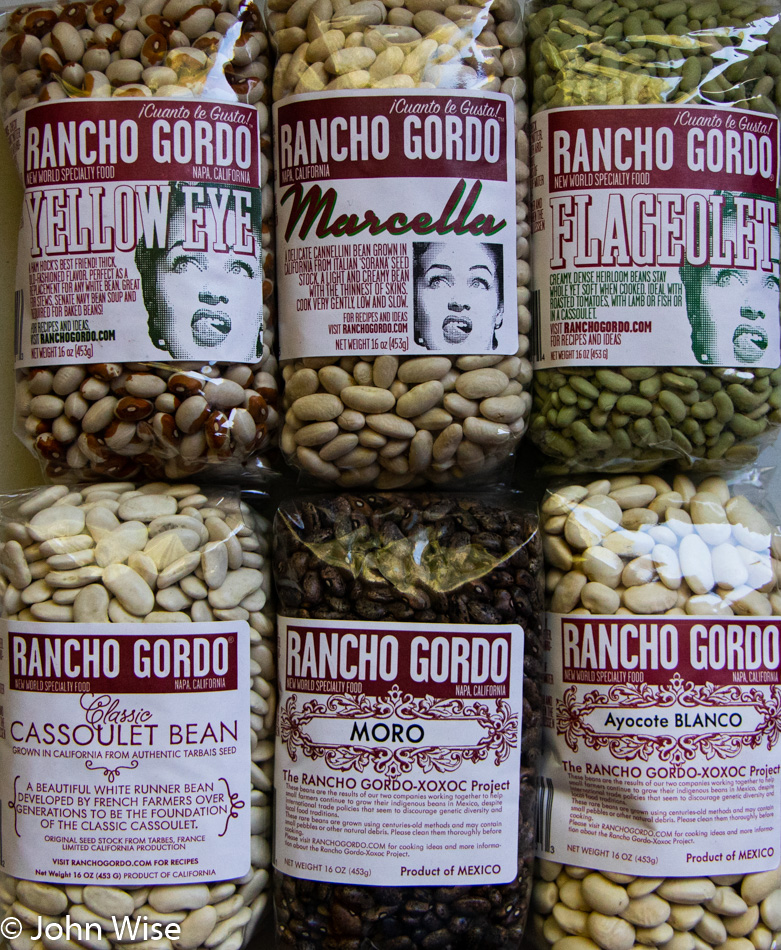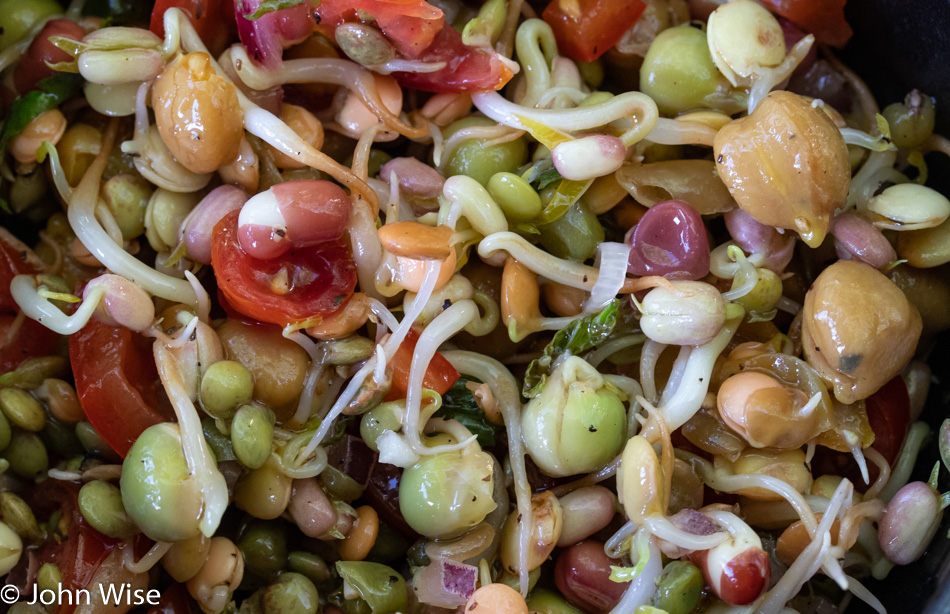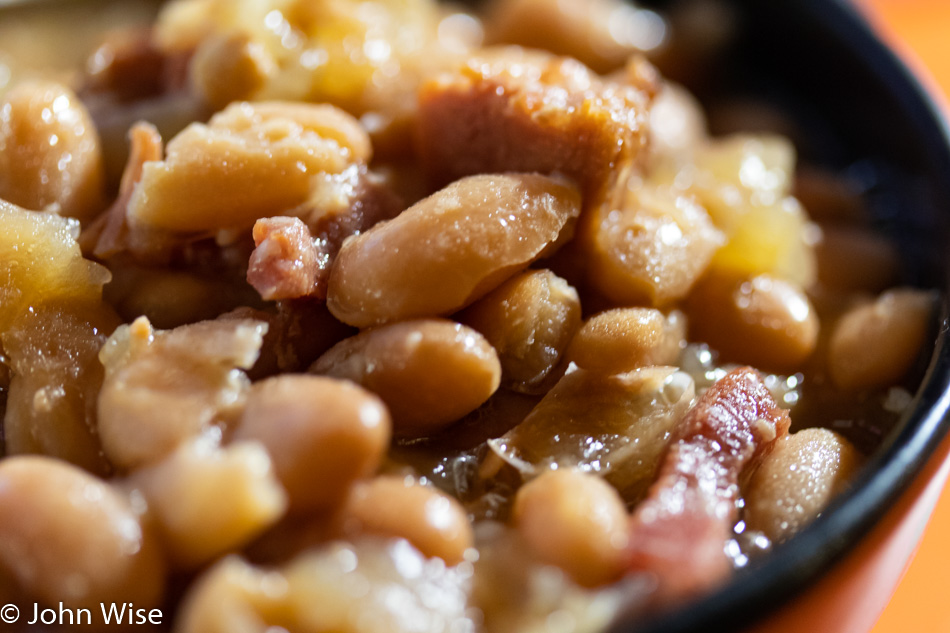
Oh my god, I had a wickedly brilliant idea: Seeing we can’t travel and I can’t share photos and blog posts detailing our incredible travels I’m going to switch things up a bit. Coming soon, I’m going to start writing about our experiences with BEANS! It won’t always be about beans but the first series will. This is really about starting a new category on my blog that will have a focus on food.
By the end of the week, Caroline and I should have a total of 31 35 36 varieties of beans on hand and while I can’t promise a blog entry a day for an entire month, I am committing to a thorough overview including photos of dry, cooking, and finished beans as we travel through the largest selection of beans we’ve ever collected. With hearts racing, I think I can hear you begging to be let in on just where I’ll be taking you; well, get ready as the list is long and magnificent.
From the photo you can see that I’m including; Yellow Eye, Marcella, Flageolet, Cassoulet, Moro, and Ayocote Blanco. We also already have the following on hand; Corona, Black Eyed, Kidney, Garbanzo, Peruano, White Tepary, Mung, Black, White, Broad, Lady Cream, and Lima del Papa. On the way to us as I just ordered these today; Mayflower, Horticulture, Spanish Tolosana, Marrow, Christmas Lima, Feijao, Lupini, Scarlet Runner, Yellow Indian Woman, Butterbean, Pigeon Pea, Turkey Craw, and Lina Sisco’s Bird Egg.
When you start looking for bean recipes you find little coming from China and Japan although adzuki or small red beans are common in desserts, while mung beans are used as bean sprouts and of course the soybean is ubiquitous. So I’m training my searches on places like Appalachia, Spain, Portugal, Africa, India to Pakistan, and of course South America.
For some of the recipes under consideration, it’s impossible to get the ingredients in Arizona, forcing me to order a number of items from D’Artagnan in New Jersey who specialize in gourmet meats of all kinds. Making something like a French cassoulet with saucisses de Toulouse (garlic sausage), duck confit, ventrèche (French pancetta), prosciutto, duck fat, or an African marrow bean dish that asks for merguez sausage (lamb) might leave you in the cold depending on where you live. I have a Spanish recipe lined up for the Tolosana beans that ask for Tocino which is Spanish bacon, that seems easy enough to make at home along with morcilla or blood sausage. Lucky us that a local German sausage company carries such a product but I’m afraid it might not be similar enough to the Spanish version that features a ton of paprika, oregano, and onion. There is an online shop called La Tienda that carries morcilla but they are currently sold out.
Food takes us places and if we were traveling to any of these locations from where I’ll be gathering recipes, we would certainly exercise our enthusiasm to sample the flavors that are not easy to find in the United States, aside from places like San Francisco, New York City and maybe a couple of others such as Los Angeles and Chicago.
Regarding this category that will become available on the side column under “View By Topic,” I’ll be posting recipes such as the sprouted dehydrated granola I shared some days ago or the ginger preparation for a Burmese salad I posted at the beginning of the month in addition to other recipes that languish on paper and various notes strewn about. Recently I made my first preparation of the Korean dish known as sundubu-jjigae or tofu soup, I didn’t capture anything about it as I wasn’t sure how Caroline and I would enjoy it, but it was so terrific we went out afterward to collect more ingredients to make sundubu part of our repertoire of dishes. Over the years we’ve experimented in making panipuri from India, Indo-Chinese dishes, African food, Peruvian pumpkin recipes, Mexican-inspired casseroles, not to forget mentioning all the recipes that have been handed down from German and Croatian relatives.
Update 1: I found a recipe from the Bolivian Andes based on peeled fava beans and so I ordered just that at Purcell Mountain Farms where they are listed as “Haba” beans.
Update 2: While looking for recipes this afternoon I came across some interesting stuff and found myself adding to my order which hadn’t shipped yet and Purcell Mountain Farms was able to add to. They are Cranberry, Cannellini, and Mortgage Lifter.
Update 3: No, I’m not ordering more beans yet but I did find this list of 14,000 bean varieties that the French recognize: https://localfoodconnect.org.au/community-gardening/list-of-french-bean-varieties/
Update 4: Okay so I just had to order these Aloyin beans aka Honey beans used in a Nigerian bean porridge. Sadly, I also have to order rainforest destroying palm oil. Maybe I can absolve my guilt knowing I’m not flying or driving anywhere so my footprint of destruction is relatively small right now….says the man sitting in an air-conditioned apartment in Arizona.





